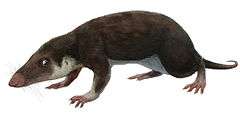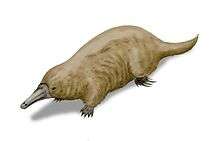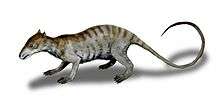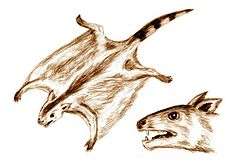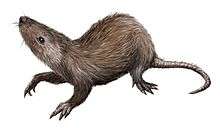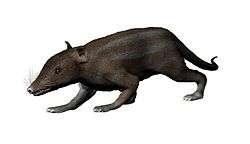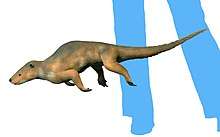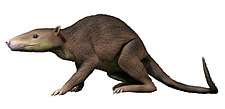Haramiyida
Haramiyidans were a long lived lineage of mammaliaform cynodonts or mammals.[1] Their teeth, which are by far the most common remains, resemble those of the multituberculates. However, based on Haramiyavia, the jaw is less derived; and at the level of evolution of earlier basal mammals like Morganucodon and Kuehneotherium, with a groove for ear ossicles on the dentary.[2] If they are early multituberculates, they would be the longest lived mammalian clade of all time. However, a more recent study, in November 2015, may dispute this and suggested the Haramiyida were not crown mammals, but were part of an earlier offshoot of mammaliaformes instead.[3][4]
| Haramiyida | |
|---|---|
| Scientific classification | |
| Kingdom: | Animalia |
| Phylum: | Chordata |
| Class: | Mammalia |
| Order: | †Haramiyida Hahn, Sigogneau-Russell & Wouters, 1989 |
| Subgroups | |
| |
Relationships
Haramiyids show certain similarities to multituberculates, a group of mammals that survived until about 40 million years ago. It is possible that haramiyids are ancestral to multituberculates, although the available evidence is insufficient to be conclusive. Certain characteristics of the teeth seem to rule out a special relationship between the two groups,[5] although some studies still unite haramiyids (or at least euharamiyids) and multituberculates in the Allotheria hypothesis.[6]
Most recently, haramiyidans have been found to be a monophyletic group of non-mammalian Mammaliaformes. In this study, gondwanatheres – usually interpreted as mammals, and derived multituberculates in particular – have been found to be deeply nested among them.[7]
Taxonomy
Order †Haramiyida[8][9] Hahn, Sigogneau-Russell & Wouters 1989 [Haramiyoidea Hahn 1973 sensu McKenna & Bell 1997]
- †Kirtlingtonia Butler & Hooker 2005 [tooth-taxa]
- Family †Haramiyaviidae Butler 2000
- †Haramiyavia Jenkins et al. 1997
- †Euharamiyida Bi et al. 2014
- Family †Arboroharamiyidae Zheng et al. 2013
- †Arboroharamiya jenkinsi Zheng et al. 2013
- Family †Shenshouidae Mao and Meng, 2019
- †Qishou jizantang Mao and Meng, 2019
- †Shenshou lui Bi et al. 2014
- Family †Eleutherodontidae Kermack et al. 1998 [Eleutherodontida Kermack et al. 1998]
- †Maiopatagium Luo et al. 2017
- †Megaconus mammaliaformis Zhou et al. 2013
- †Millsodon superstes Butler & Hooker 2005 [tooth-taxa]
- †Eleutherodon oxfordensis Kermack et al. 1998
- †Xianshou Bi et al. 2014
- †X. linglong Bi et al. 2014
- †X. songae Bi et al. 2014
- †Sineleutherus Martin, Averianov & Pfretzschner 2010
- †S. uyguricus Martin, Averianov & Pfretzschner 2010
- †S. issedonicus Averianov, Lopatin & Krasnolutskii 2011
- †Vilevolodon Zhe-Xi Luo, 2017
- †Vilevolodon diplomylos Zhe-Xi Luo, 2017
- Family †Theroteinidae Sigogneau-Russell, Frank & Hammerle 1986
- †Theroteinus nikolai Sigogneau-Russell, Frank & Hammerle 1986
- †Theroteinus rosieriensis Sigogneau-Russell 2016[10]
- Family †Haramiyidae Poche 1908 [Haramiyidae Simpson 1947 sensu Jenkins et al. 1997; Microlestidae Murry 1866; Microcleptidae Simpson 1928]
- †Eoraetica
- †Hypsiprymnopsis rhaeticus Dawkins, 1864[11] [Microlestes rhaeticus Dawkins, 1864]
- †Avashishta bacharamensis Anantharaman & al. 2006
- ?†Allostaffia aenigmatica (Heinrich 1999) Heinrich 2004 [Staffia Heinrich 1999 non Schubert 1911; Staffia aenigmatica Heinrich 1999]; possible gondwanathere instead.[12]
- †Thomasia Poche 1908 [Haramiya Simpson 1947; Microlestes Plieninger 1847 non Schmidt-Goebel 1846; Microcleptes Simpson 1928 non Newman 1840; Plieningeria Krausse 1919; Stathmodon Henning 1911]
- †T. woutersi Butler & MacIntyre 1994
- †T. hahni Butler & MacIntyre 1994
- †T. moorei (Owen 1871) Butler & MacIntyre 1994 [Haramiya moorei (Owen 1871) Simpson 1947; Microleptes moorei Owen 1871; Microcleptes moorei (Owen, 1871) Simpson, 1928] [upper tooth]
- †T. antiqua (Plieninger 1847) Poche 1908 [Microlestes antiquus Plieninger 1847; Haramiya antiqua (Plieninger 1847); Microleptes fissurae Simpson 1928; Haramiya fissurae (Simpson 1928); Haramiya butleri Sigogneau-Russell 1990; Thomasia anglica Simpson 1928] [lower tooth]
In May 2018, a new genus and species was named, and is believed to be a member of Hahnodontidae:
- †Cifelliodon wahkarmoosuch Huttenlocker et al. 2018[7]
Lifestyle
Haramiyids seem to have generally been herbivorous or omnivorous, possibly the first mammalian herbivores; however, the sole haramiyid tested in a study involving Mesozoic mammal dietary habits, Haramiyavia, ranks among insectivorous species.[13] At least some species were very good climbers and were similar to modern day squirrels;[14] and several others have more recently been reassessed as possibly arboreal. General arboreal habits might explain their rarity in the fossil record.[15]
Several haramiyidans, Maiopatagium, Xianshou, Vilevolodon and Arboroharamiya, took it one step further and developed the ability to glide, having extensive membranes similar to those of modern colugos. In many of these taxa, the coracoid bones (absent in modern therians but present in many other mammal groups, albeit highly reduced) are remarkably large and similar to those of birds and pterosaurs, presumably due to impact stresses at landing.[16][17]
Mammalian tooth marks on dinosaur bones may belong to Sineleutherus, suggesting that some haramiyidans scavenged on dinosaur remains.[18]
Range
Most fossils have been reported from Europe, but some are known from Africa and Greenland. Since 2005, the published range extended to Mongolia and China. The age of haramiyid fossils range from Upper Triassic up to Late Cretaceous. This has important implications: the fact that haramiyids were present in the Late Triassic supports the idea that crown-group mammals originated at least 208 million years ago, much earlier than some previous research suggests.
The youngest haramiyid fossil genus is Avashishta bacharamensis from the Maastrichtian of India. Cretaceous haramiyids are previously known from the Early Cretaceous of Morocco, suggesting that these animals may have survived in gondwannan landmasses as relics; the presence of the similarly aged Cifelliodon in North America suggests that contact between both landmasses remained for a while. With a temporal range of at least 150 million years, they are the longest lived mammaliaform lineage.[19][20]
Notes
- Zheng, Xiaoting; Bi, Shundong; Wang, Xiaoli; Meng, Jin (2013). "A new arboreal haramiyid shows the diversity of crown mammals in the Jurassic period". Nature. 500 (7461): 199–202. doi:10.1038/nature12353. ISSN 0028-0836. PMID 23925244.
- Butler PM, 2000
- Chang, Kenneth (16 November 2015). "Jawbone in Rock May Clear Up a Mammal Family Mystery". New York Times. Retrieved 17 November 2015.
- Luo, Zhe-Xi; Gates, Stephen M.; Jenkins Jr., Farish A.; Amaral, William W.; Shubin, Neil H. (16 November 2015). "Mandibular and dental characteristics of Late Triassic mammaliaform Haramiyavia and their ramifications for basal mammal evolution". PNAS. 112 (51): E7101–E7109. doi:10.1073/pnas.1519387112. PMC 4697399. PMID 26630008. Retrieved 17 November 2015.
- Monastersky 1996, p.379
- Butler & Hooker 2005, p.206
- Huttenlocker, Adam K.; Grossnickle, David M.; Kirkland, Jam,es I.; Schultz, Julia A.; Luo, Zhe-Xi (23 May 2018). "Late-surviving stem mammal links the lowermost Cretaceous of North America and Gondwana". Nature. doi:10.1038/s41586-018-0126-y. Retrieved 23 May 2018.
- Mikko's Phylogeny Archive Haaramo, Mikko (2007). "†Haramiyida". Retrieved 30 December 2015.
- Paleofile.com (net, info) . "Taxonomic lists – Mammals". Retrieved 30 December 2015.
- Debuysschere, Maxime (2016). "A reappraisal of Theroteinus (Haramiyida, Mammaliaformes) from the Upper Triassic of Saint-Nicolas-de-Port (France)". PeerJ. 4: e2592. doi:10.7717/peerj.2592. PMC 5075691. PMID 27781174.
- W. B. Dawkins. 1864. On the Rhaetic beds and White Lias of western and central Somerset; and on the discovery of a new fossil mammal in the grey marlstones below the bone-bed. Quarterly Journal of the Geological Society 20:396-412
- Nicholas Chimento, Frederico Agnolin, Agustin Martinelli, Mesozoic Mammals from South America: Implications for understanding early mammalian faunas from Gondwana, May 2016
- David M. Grossnickle, P. David Polly, Mammal disparity decreases during the Cretaceous angiosperm radiation, Published 2 October 2013.DOI: 10.1098/rspb.2013.2110
- "Three extinct squirrel-like species discovered". ScienceDaily. 2014-09-11. Archived from the original on 18 September 2014. Retrieved 2014-10-07.
- Jing Meng, Mesozoic mammals of China: implications for phylogeny and early evolution of mammals, Natl Sci Rev (December 2014) 1 (4): 521-542. doi: 10.1093/nsr/nwu070 First published online: October 17, 2014
- Qing-Jin Meng; David M. Grossnickle; Di Liu; Yu-Guang Zhang; April I. Neander; Qiang Ji; Zhe-Xi Luo (2017). "New gliding mammaliaforms from the Jurassic". Nature. in press. doi:10.1038/nature23476.
- A Jurassic gliding euharamiyidan mammal with an ear of five auditory bones, Nature doi:10.1038/nature24483
- https://link.springer.com/article/10.1007/s00114-020-01688-9
- Anantharaman, S.; Wilson, G. P.; Das Sarma, D. C.; Clemens, W. A. (2006). "A possible Late Cretaceous "haramiyidan" from India". Journal of Vertebrate Paleontology. 26 (2): 488–490. doi:10.1671/0272-4634(2006)26[488:aplchf]2.0.co;2.
- Ashok Sahni, New evidence for palaeogeographic intercontinental Gondwana relationships based on Late Cretaceous-Earliest Palaeocene coastal faunas from peninsular India, Washington DC American Geophysical Union Geophysical Monograph Series 01/1987; 41:207–218. doi:10.1029/GM041p0207
External links
- Palaeos, Mammaliaformes: Allotheria
- John H Burkitt, Mammals, A World Listing of Living and Extinct Species. Archived from the original on 21 December 2004. Retrieved 2015-06-18.
- Mikko K Haaramo, Haramiyida
References
- Zofia Kielan-Jaworowska, Richard L. Cifelli, and Zhe-Xi Luo, Mammals from the Age of Dinosaurs: Origins, Evolution, and Structure (New York: Columbia University Press, 2004), 249–260.
